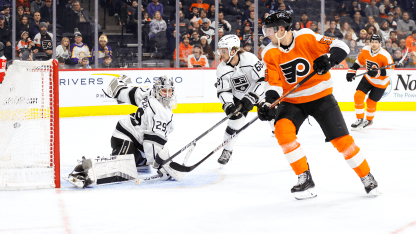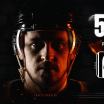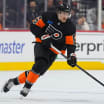Flyers defenseman Rasmus Ristolainen dealt with an injury during training camp and his struggling early season play got him off on the wrong track with new head coach John Tortorella. He was a healthy scratch in the Flyers' 2-1 road win in Ottawa on Nov. 5.
Friday Forecheck: Risto is Rolling
Flyers Contributor Bill Meltzer takes a look at Defenseman Rasmus Ristolainen's continued improvement over the course of the season

With characteristic bluntness, head coach John Tortorella stated that he needed to see large-scale improvement from the 28-year-old Finn.
"I don't think he's played well enough. He's going to get another crack at it, but everything about his game, I think, needs to be better," Tortorella said at the time.
The player took it in stride.
"I think it's how it should be," Ristolainen said upon his Nov. 8 return to the lineup. "If you don't play to the level that's expected, you don't earn being in the lineup."
Since that time, Ristolainen's game has steadily come around. At the behest of assistant coach Brad Shaw, the player has simplified his game. Ristolainen has taken himself out of position less often in looking to deliver crushing bodychecks. His hits are down (7.33 per 60 minutes of ice time from 9;75 per 60 in 2021-22) but he's been more effective on the whole. He's been in better position to block shots (7.48 blocks per 60 in 2022-23, up from 5.30 per 60 in 2021-22.
Ristolainen has also been better slotted by the current coaching staff into more manageable matchups compared to the years when the Sabres overused him in the most difficult of all-situations matchups. His 18:05 average ice time this season is significantly below his 23:15 career average and also down from the 21:26 he averaged last year in his first season as a Flyer.
However, Ristolainen has been doing more with less.
"He's been killing more plays and making better plays," Tortorella said on Jan. 20. "Shawsy has worked a lot with him. His stick is better. He's been using his legs better. He's moved the puck better. Just a little more under control....He's been strong. I think he's a guy that guys pull for. He's put up some (offensive) numbers early in his career but right now I'm just concerned where he is defensively."
During his years with the Buffalo Sabres, Ristolainen was a regular on the power play. He had four straight seasons in which he posted 41 to 45 points. In more recent years, his offensive responsibilities have been lessened.
For the 2022-23 season to date, Ristolainen has chipped in a modest seven points (two goals, five assists). However, five of his points -- including both of his goals -- have come over the team's last six games.
On Jan. 17 against Anaheim, Ristolainen scored the first shorthanded goal of his NHL career. It was no seeing-eye shot or something that deflected into the net off a defender. Ristolainen jumped into the rush to take a pass from Scott Laughon. Moving in on former Flyers goalie Anthony Stolarz, "Risto" shifted to his backhand and the right-handed shooter elevated the puck over the goaltender and into the net. On the bench, teammates whooped it up in celebration.
Earlier this week, in the Flyers' 4-3 overtime loss to the LA Kings at the Wells Fargo Center, Ristolainen went to the net as puck-carrier Morgan Frost moved up high in the zone and put the puck toward the net. James van Riemsdyk deflected it and the puck went directly to Ristolainen. The big Finn kicked the puck from his skate to his stick blade and deposited a backhander into the net.
"I didn't have too many (goals) in me, so it's always nice when you can score," Ristolainen said on Jan. 17. "It's nice to see everyone excited and kind of being hapy with me..... I know my role is to be defensive but it feels good when you contribute in some different ways."
Paired for most of last season and segments of the current campaign with Travis Sanheim, Ristolainen has more recently skated primarily on the Flyers' third pairing with Nick Seeler. He also saw a few games earlier this season with Ivan Provorov.
One of the primary criticisms that Ristolainen has received over the years from analytics devotees has been poor underlying numbers in puck possession and expected goals differentials when he's on the ice. This season, particularly of late, Ristolainen has shown improvement in his re-defined role.
Using the sample size of the 15 games the Flyers have played since the leaguewide holiday break, Ristolainen has been on the positive side of the expected goal ledger at 5-on-5 (58.57%) and basically at a break even point in shot attempt differentials (Corsi) at 49.74 percent.
It's a small slice of a season, yes. But it shows that apart from delivering hits, blocking shots and chipping in a few points up ice of late, Ristolainen has not recently been a detriment in even the most-maligned aspect of his game. He's not the only reason why the Flyers are 9-4-2 since the holiday break, of course, but Ristolainen's all-around play has been a net positive for the Flyers in recent weeks. He's come a long way since his rocky start to the season.
A look at the Young Guns
Below are some updates to a section of Thursday's "Five Things" Game Preview before the Flyers' 3-2 overtime loss to the Minnesota Wild: a look at how the Flyers' group of players younger in the 25-and-under age group (minus Travis Konecny) have fared over roughly the last quarter-season. The sample size looked at is now the last 22 games.
* Morgan Frost has 18 points in the last 22 games (7g, 11a), tied with Laughton for the second-most on the club in that span. His nine credited takeaways are tied for fourth and he has even been credited with 34 hits. He has also improved in the faceoff circle in that span, essentially breaking even at 50.2 percent (140 wins, 139 losses).
* Twenty-three-year-old Owen Tippett, Frost's regular 5-on-5 linemate along with veteran James van Riemsdyk, has 15 points (6g, 9a) in his last 22 games. Tippett also leads the Flyers with 16 credited takeaways in that span. The line's left winger, JVR has 16 points (6g, 10a) in the last 22 games.
* Twenty-five-year-old power forward Wade Allison sustained a lower-body injury in blocking a shot early in the second period of Thursday's game in Saint Paul. He skated one subsequent 10-second shift but was unable to continue and left the game. Hopefully, for the sakes of both the entire team and the oft-injured player himself, Allison won't miss much time. He returned 18 games ago from an 18-game stint on Injured Reserve due to an oblique strain and hip pointer. It took him some time to recover his form but he has come on offensively of late (four points in his last five game). Over the last 18 games, Allison has posted seven points (4g, 3a) and is third on the team with 52 credited hits. He's posted a 2-to-1 ratio of credited takeaways (6) to charged giveaways (3) since his return. In general, he's playing more of the north-south game that Tortorella wants him to play.
* The most NHL-established member of the Flyers' 25-and-under group is left winger Joel Farabee. The 22-year-old, who underwent neck surgery in the offseason, has had an-and-down 2022-23 campaign by his standards but has periodically shown flashes of the form that got him promoted to the Flyers' top line. Farabee, who has dressed in every game this season, has 10 points (4g, 6a) over the last 22. Presently, he's one of the main guys the Flyers need to pick up on his recent pace. Farabee exited Thursday's game pointless in his last seven. Before that, he had a stretch of three goals and seven points in six games between Jan. 2 to Jan. 14. Getting more consistency from Farabee will be one of the keys to a successful post-All Star break period for the club.
* Noah Cates scored the game's first goal in Thursday's tilt in his home state of Minnesota. Moved from left wing to center at the start of the season,the 23-year-old rookie almost immediately became one of Tortorella's most trusted forwards on the team. Even when not scoring, he's been defensively responsible and a tenacious forechecker. Over the last 22 games, Cates is ninth on the Flyers in points (4g, 7a). Tortorella uses Cates in all game situations, including both the penalty kill and power play as well as late in tied or one-goal games. As with Frost, he's still working to improve on faceoffs (42.8 percent over the last 22 games, 39.4 percent for the season). Cates is tied with Frost for fourth on the team with nine credited takeaways in the last 22 games.
* Defenseman Cam York was recalled from the AHL's Lehigh Valley Phantoms 23 games ago. This time around, it looks like the blueliner (who turned 22 on January 5) is in the NHL to stay. He's improved his consistency on both sides of the puck. Over the last month, York has played on the top 5-on-5 defense pairing with Ivan Provorov and is also a power play regular. Offensively, he's posted 10 points (1g, 10a) and averaged 19:37 of ice time. Since Christmas, he's averaged 20:11 of ice time.
Power play personnel units shuffled in Minnesota
The Flyers did not have their first power play of the game against the Wild until the second period. The game was tied, 1-1, at that point. The Flyers sent out a different arrangement of their power play personnel that what had been featured in each of the previous four games (against Chicago, Detroit, Winnipeg and Los Angeles):
PP units in the previous 4 games
PP1: Tippett, Laughton, Konecny, Farabee (or JVR), York.
PP2: Hayes, Frost, JVR (or Farabee), Cates, DeAngelo.
PP units @ Minnesota
PP1: Laughton, Hayes, Konecny, JVR, DeAngelo
PP2: Cates, Frost, Tippett, Farabee, York
The Flyers went 0-for-3 on the power play in Minnesota but they moved the puck well in two of the three opportunities. It will be interesting to see if the units from the Wild game hold in Winnipeg on Saturday or if there is further tweaking.
Line shuffling by necessity
For the last 17 games, the Flyers were able to start the same combination of 12 forwards and six defensemen in every game. Tortorella sometimes made in-game changes but he always reverted to the familiar four line combinations and three defensive pairs at the start of the next game. In Minnesota, both Allison (lower-body) and Zack MacEwen (upper body) were injured, leaving the Flyers with just 10 forwards before the midway point of regulation.
For the Winnipeg game, depending on the severity of Allison and MacEwen's injuries, the Flyers will need to make some changes. Kieffer Bellows (a healthy scratch for the duration of his current NHL recall since Jan. 5) is available to play. If both Alllison and MacEwen are out, the Flyers could either dress Justin Braun and go with seven defensemen or they could make a recall from the AHL's Lehigh Valley Phantoms.
During the Minnesota game, Tortorella also shuffled around the upper lines, breaking up the trio of JVR, Frost and Tippett. Tippett played many of his latter game shifts with Scott Laughton. Frost variously saw shifts with Hayes, Farabee, and Patrick Brown (who had an excellent scoring chance early in the third period).
What will the starting line look like in the rematch against the Jets? That remains to be seen. The Flyers will not practice on Friday.
Overtime: Nine points left on the table
Nowadays, most NHL teams prefer to use two forwards and one defenseman on the ice during 3-on-3 sudden death overtime. With the Flyers having lost each of their first five games that were decided in overtime (0-4 in OT decisions, 0-1 in shootouts), they made a change starting in the Dec. 9 game in Vegas. Beginning with that game, the Flyers began to primarily use a 1F/2D setup on overtime.Since the change was made, the Flyers have gone 1-4 in overtimes for a 1-9 season record in matches decided beyond regulation. The lone Flyers win past regulation was a 2-1 overtime victory in San Jose on Dec. 29.
"I'm happy to get a point but it leaves you wanting more," Tortorella said after Thursday's 3-2 overtime loss in Minnesota.
However, the coach pointed out that each of the last two overtime losses -- against the Kings and Wild -- saw the Flyers have a prime scoring chance at one end of the ice and then the other team scored in transition the other way. Against LA, Scott Laughton hit the post, Sanheim was denied from close range and DeAngelo either fell or was tripped before LA scored off a 2-on-1 to end the game. In Minnesota, Konecny was stopped by Marc-Andre Fleury on a 2-on-1 as he tried to wait out the veteran goalie and then shoot. One -- or both -- games just as easily could gone the other way. Also of note: On the game-ending sequence against the Wild, the Flyers did have two forwards (Hayes and Konecny) on the ice.
Among Flyers defensemen, Tortorella is most likely to use the offense-oriented DeAngelo (1:40 TOI average per OT game played), York (1:10), Sanheim (1:02) and Provorov (0:58). Among forwards, he most often turns to Konecny (1:16), Hayes (1:02), and Laughton (0:41). Earlier in the season, before the switch from 2F/1D to 1F/2D, the Flyers also worked in Farabee (0:38), Tippett (0:38), Frost (0:30) or Cates (0:20). More recently, it's been very much an almost exclusive rotation of three forwards and three or four defensemen.
Any which way one slices and dices the ice time or arranges the skaters, the bottom line is this. There have been 10 "bonus points" up for grabs between the Flyers and their opponents in the 10 overtime/shootout decisions. The Flyers have only claimed one and left nine on the table.


















